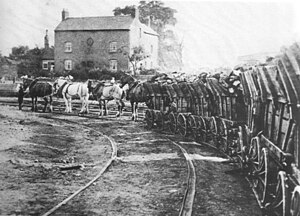Little Eaton Gangway

The Little Eaton Gangway in 1908 with the last train of loaded coal waggons
|
|
| Locale | England |
|---|---|
| Dates of operation | 1795–1908 |
| Track gauge | 3 ft 6 in (1,067 mm) and 4 ft (1,219 mm) |
| Length | 5 miles (8 km) |
| Headquarters | Little Eaton |
The Little Eaton Gangway, or, to give it its official title, the Derby Canal Railway, was a narrow gauge industrial wagonway serving the Derby Canal, in England, at Little Eaton in Derbyshire.
In 1792, Benjamin Outram was asked to prepare plans for a broad canal from Swarkestone to Smithy Houses, near Denby, with a branch at Derby to the Erewash Canal at Sandiacre, which he estimated would cost £60,000. The original report has been lost in time with only a dated and signed map drawing surviving in Derbyshire Records Office. William Jessop on 3 November 1792 confirmed Outram's proposals. The Derby Canal Act of 1793 authorized a rail connection between the Derby Canal at Little Eaton and the collieries to the north. The wagonway ran four miles (6 km) from the canal wharf to Smithy Houses and another mile further to Denby Hall Colliery. Further short branches served Salterwood North and Henmoor Collieries as well as the Denby Pottery.
The purpose of this 5-mile (8 km) long plateway was to carry coal from Kilburn and Denby down to the canal at Little Eaton and general goods including stone, pottery and "clogs of wood".
Outram's original plan was for a conventional waggonway with wooden sleepers and oak rails reinforced with cast iron plates. Accordingly, an advertisement appeared in the Lincoln & Stamford Mercury for 16 August 1793 for oak sleepers 4 feet 6 inches (1.37 m) long squared at each end for a length of 9 inches (230 mm).
However, by the time the railway was approved, Outram had decided to use the flanged rails with which his name has become associated. In this he may have been greatly influenced by William Jessop (1745 to 1814) and also by Joseph Butler of Wingerworth near Chesterfield, who had constructed a similar line in 1788. Butler is believed to have been the first to do so in Derbyshire and supplied the rails, rather than Outram's own works. Outram considered himself the first to use stone blocks as sleepers. These were drilled with a six-inch (150 mm) hole into which an oak plug was fitted. The rails of cast iron were usually three feet long (he also manufactured 4 foot long rails when asked) and of L-shaped cross-section, were attached by means of spikes into a notch at the end of the rail. The line was originally 3 ft 6 in (1,067 mm) gauge, being increased later to 4 ft (1,219 mm) at an unknown date.
...
Wikipedia
